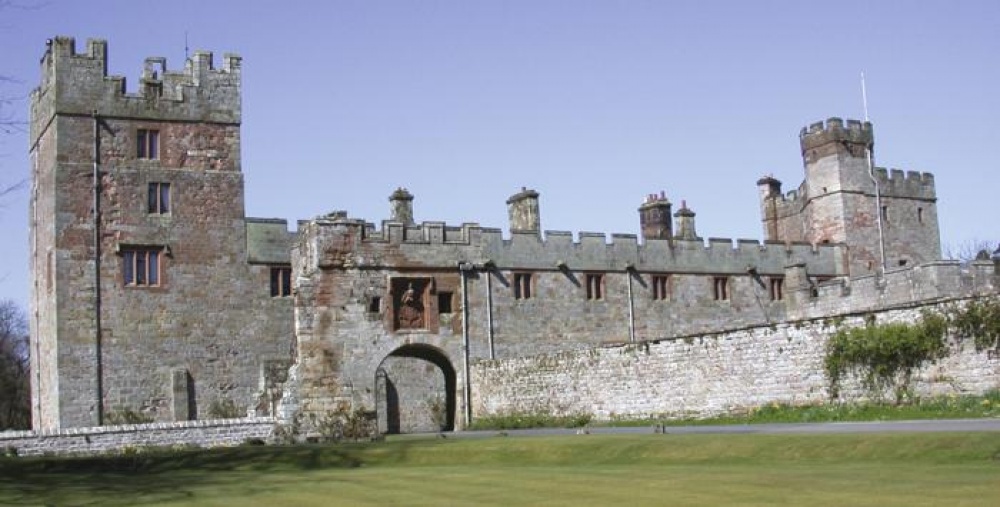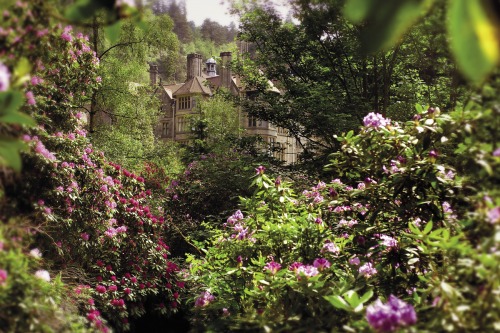Meet the Owners of Naworth Castle in Cumbria

It is said that an Englishman’s home is his castle, but what about those for whose home literally is a castle?
He was awarded lands around Lanercost, and with that new wealth was able to extend Naworth. He was also Warden of The West March for Henry VIII, and provided loyal service to the crown until his death in 1525. Unfortunately for the Dacre family, in 1560 the then Lord Dacre died, leaving a widow, three daughters and a young son called George.
Thomas Howard, fourth Duke of Norfolk, married the widowed Lady Dacre, and arranged to marry his three sons to her three daughters. Young George was killed in a fall from a vaulting horse and the vast Dacre estates, all came under the control of the Howard family.
The eldest Dacre daughter, Elizabeth, married the Duke’s third son, Lord William Howard. It took Lord William until 1602 to raise and pay a ransom of £10,000, in order to secure his wife’s estate. He served both James I and Charles I, and was responsible for the maintenance of law and order. In the castle grounds stands the stump of the renowned oak tree where Lord William Howard used to hang Scottish Reivers and wrongdoers. It was said he hung 63 Armstrongs in two years!
Lord William’s great grandson, Charles Howard, amassed an enormous fortune which enabled his grandson, the third Earl of Carlisle, to commission Vanbrugh to build Castle Howard. Increasingly the Earls of Carlisle used Castle Howard as their main residence, and Naworth was very much a secondary home, left as an old medieval fortification.
Unfortunately, in 1844 there was a disastrous fire, which destroyed virtually all of the Castle. The reconstruction of the Castle commenced in the 1850s. Most of the structure was restored by the illustrious Victorian architect Anthony Salvin, while the interior was reconstructed by the ninth Earl of Carlisle, George Howard, and his wife Rosalind.
The ninth Earl’s circle of friends included Philip Webb, Edward Burne-Jones, William Morris and many other eminent Pre Raphaelites. All were regular house guests, and their signatures can be seen today in the visitors’ book.
George died in 1911, leaving Naworth and a small entail of land to his eldest son Charles, the tenth Earl of Carlisle. Naworth passed to George, the 11th Earl of Carlisle, and subsequently to Charles 12th Earl of Carlisle. Philip, the second son of the 12th Earl, purchased Naworth from his father in 1994. He married Elizabeth in 1992, and the family now live in the Castle.
Philip explains, ‘In order to keep the castle I had to buy it and then we ran it as a full business doing a lot of weddings, conferences and corporate events until 2001, when Foot and Mouth had a huge impact on the business. We decided then to move back into the castle, but we also still carry out a number of functions and events – this year sees two high quality Galloway Antique Fairs (20th to 22nd April and 31st August to 2nd September) as well as a number of wedding ceremonies.
We have done a number of film shoots and we even had a live National Lottery Draw, which included Anthea Turner and Mystic Meg scuttling around on the battlements! A couple of years ago we were used for a BBC film – Elizabeth: The Virgin Queen – with Anne Marie Duff and Tom Hardy. They used our courtyard to film the burning of Latimer and Ridley and they also allowed me to be the executioner and set them alight, which was pretty entertaining!’
With such an illustrious history, stretching from 1335 to the present day, Philip admits that it’s hard to pick just one highlight. ‘The whole place is so beautiful. I have been lucky enough to be given the chance to completely remodel the estate and take it from what was a declining traditional estate into something that now has a modern relevance and is hopefully financially strong enough to allow future generations of my family to continue.’
He has invested a huge amount of both money and work into the estate during the last 20 years – the really big and important project was his redevelopment of one of the old farm steadings at Lanercost. ‘By the time I finished it cost well over £1,500,000, which created three Grade II listed residential cottages, a renovated five bedroomed farmhouse which is now a highly successful 5 star B&B, let to Bob and Christina Lamb, a large Tea Room, Farm Shop and Gallery (now Visitor Centre) with a footfall of 20,000, which is brilliantly run by Mike and Victoria Farley and six high quality four star/ four star Gold holiday cottages called Lanercost Holiday Cottages, which we run ourselves and are proving to be very popular.
I have also renovated virtually all of the houses on the estate. Denton Hall has been let as a B&B with livery stables, which complement our holiday cottages. We try to ensure that all of our holiday cottage guests get a tour of Naworth included where possible. We have a 12 acre lake which I dredged and is now let as a trout fishing lake. Over the last four years we have managed to go through all of our beautiful neglected oak woodlands, restore many paths, thin, fell and replant with native species.’
It’s important to Philip that Naworth remains somewhere that can be enjoyed by the public, and ideally continues to be cared for by the family. ‘I love Naworth with a passion and obviously it would be wonderful if one of my children was keen enough to continue it. I have always said that I would not wish to bequeath them something that would ruin them – neither would I like them to ruin it. Many of these properties cost an absolute fortune to maintain.
At the moment we are in an age of austerity and everybody is hurting. Understandably, people expect the rich or people they perceive to be rich to pay their share or more. The way things are going, especially with regulations and higher costs, houses like ours are increasingly difficult to maintain, let alone carry out the extraordinarily difficult works associated with their capital restoration.
The Government needs to understand that, because increasingly if an old family estate or historic house is sold now, the sort of people who will purchase them tend to be squillionaires who will almost certainly ensure that they are no longer open to the public, and in many cases a lot of the historical content and heritage of a local area disappears, or else the buildings are used for some kind of commercial purpose. As in most cases it is about striking the right balance to keep these places alive.’









